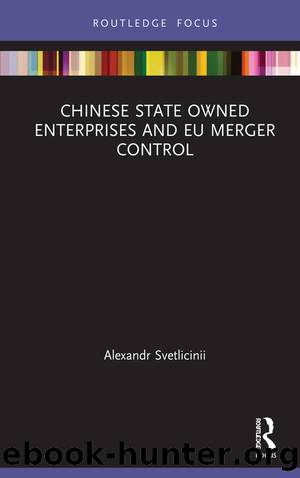Chinese State Owned Enterprises and EU Merger Control by Alexandr Svetlicinii

Author:Alexandr Svetlicinii
Language: eng
Format: epub
Publisher: Taylor and Francis
Published: 2021-04-15T00:00:00+00:00
3.3 Setting the precedent: the EDF/CGN/NNB decision
The CGN decision is the first decision involving a Chinese SOE in which the Commission has taken a firm stance on jurisdiction and abandoned, although to a limited extent, its âwait and seeâ approach.53
53 Kyriakos Fountoukakos and Camille Puech-Baron, âChina/EU: The Gradual Evolution of the EU Commissionâs Merger Control Decisional Practice Towards SOEs Amidst an Increasingly Protectionist Worldâ (2017) Concurrences N° 4â2017, Art. N° 84891 <www.concurrences.com/en/review/issues/no-4-2017/international/kyriakos-fountoukakos> accessed 31 July 2020, 5.
In 2016, the Commission examined a concentration whereby the French SOE Electricité de France S.A. (EDF) and the Chinese SOE China General Nuclear Power Corporation (CGN) sought to acquire joint control over NNB companies, which operated three nuclear power plants in the United Kingdom: Hinkley Point, Sizewell, and Bradwell.54 At the time of notification, CGN was controlled by the Central SASAC (90% of shares), while the minority shareholding (10%) was held by the Guangdong SASAC.
54 EDF/CGN/NNB Group of Companies (Case No. COMP/M.7850) [2016] OJ C151/1, decision of 10 March 2016.
According to CGN, it enjoyed operational independence from the Central SASAC due to the following circumstances: (1) the SOE law in China proclaimed separation of ownership from control; (2) the Central SASAC can appoint or remove CGNâs management but cannot interfere with the day-to-day operations of the SOE; (3) CGN does not have any interlocking directorships with the SASAC.55 The Commission, in its assessment, has referred to other provisions of Chinaâs SOE law and SASACâs regulations, which authorized the SASAC to supervise the investment decision making of the SOEs.56 The SASACâs powers to appoint/remove senior management and to approve the investment plans of the SOE allowed the Commission to conclude that âCentral SASAC participates in major decision making, in the selection and supervision of senior management of SOEs and can interfere with strategic investment decisionsâ.57 According to the Commission, the ability of the Central SASAC to coordinate the activities of the SOEs under its control was evidenced by the fact that in 2014 several centrally owned SOEs formed the China Nuclear Industry Alliance (CNIA).58 With reference to the report of the World Nuclear Association, the Commission noted that the establishment of the CNIA was âdirected by the [Chinese] government to achieve some synergyâ and is âdesigned to eliminate detrimental or unseemly competition in export marketsâ.59
55 Ibid., paras 34â36.
56 Ibid., para 39.
57 Ibid., para 42.
58 Ibid., para 44.
59 Ibid.
The ultimate conclusion reached by the Commission in the present case was as follows:
[i]n view of the fact that Central SASAC can interfere with strategic investment decisions and can impose or facilitate coordination between SOEs at least with regard to SOEs active in the energy industry, the Commission concludes in the case at hand that CGN and other Chinese SOEs in that industry should not be deemed to have an independent power of decision from Central SASAC.60
Such an assessment prompted the comment that âthe Commission satisfied itself with the analysis of formal legal documents and with the fact of possibility or capacity that they give to Central SASAC to control and coordinateâ.
Download
This site does not store any files on its server. We only index and link to content provided by other sites. Please contact the content providers to delete copyright contents if any and email us, we'll remove relevant links or contents immediately.
The Fifteen Biggest Lies about the Economy: And Everything Else the Right Doesn't Want You to Know about Taxes, Jobs, and Corporate America by Joshua Holland(817)
The World For Sale by Javier Blas(617)
The Economist (20210109) by calibre(566)
Made in China by Anna Qu(540)
Philippines--Culture Smart! by Culture Smart!(502)
Boom and bust a global history of financial bubbles by Quinn William Turner John(483)
The Dictatorship of Woke Capital by Stephen R. Soukup(482)
Big Money by Kenneth P. Vogel(481)
Forex Trading All In One For Dummies by Mishra Mamta(478)
The Money Revolution by Anne Boden(470)
Tax the Rich! by Morris Pearl(458)
Cross Winds: Adventure and Entrepreneurship in the Russian Far East by Myers Steven(454)
Mission Economy by Mariana Mazzucato(454)
The New Retirement Savings Time Bomb by Ed Slott(448)
The Inflation Myth and the Wonderful World of Deflation by Mark Mobius(433)
Fundamentals of Finance by Mustafa Akan Arman Teksin Tevfik(417)
The Great Demographic Reversal by Charles Goodhart & Manoj Pradhan(416)
How Finance Is Shaping the Economies of China, Japan, and Korea by Hugh Patrick(406)
Business Recoded by Peter Fisk(405)
